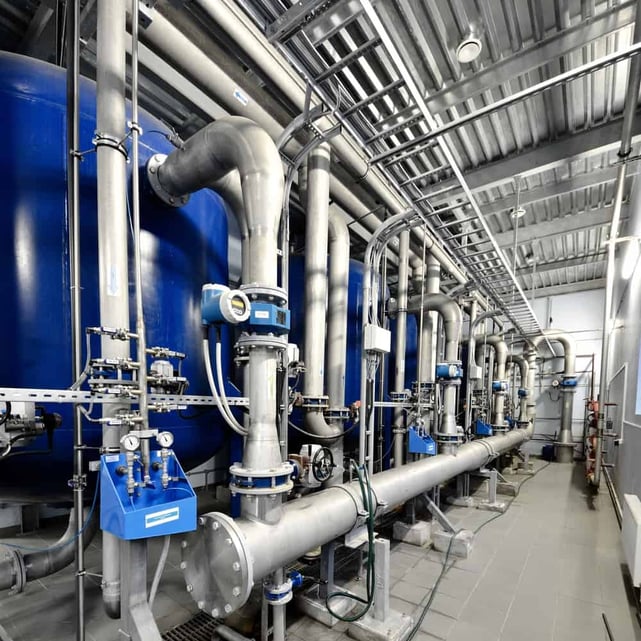Share this
Meeting ASME Boiler and Pressure Vessel Codes Through Design and Material Selection
by Morgan Zealear on 12/22/22 9:00 AM

American Society of Mechanical Standards (ASME) standards govern the material selection and design specification for various mechanical equipment and devices. The Boiler and Pressure Vessel (BPVC) standard, in particular, constitutes a large part of the ASME standard, which covers the design, construction, maintenance, and inspection of the boiler and pressure vessels in nuclear, pharmaceutical, petrochemical, and other industries where fluid systems play a prominent role.
Only through understanding the relevant ASME boiler and pressure vessel codes can it be possible to incorporate safe design elements for the overall fluid system. So, let us discuss the applicable standards and how meeting them will require the use of high-quality components and expertise in design.
Understanding ASME Boiler and Pressure Vessel Codes for Fluid System Design
Boilers and pressure vessels are an integral part of the fluid system with extreme process conditions. This is where fluids are stored or processed at substantially high temperatures and pressures or extremely low temperatures. In different industries, these boiler and pressure vessels may be used in various forms, such as heat exchangers, condensers, and storage tanks.
The ASME BPVC addresses the aspects of fabrication, inspection, and maintenance of boiler and pressure vessels. The following is the summary of the BPVC standard by section:
- Section I and VII includes the requirements for design and fabrication, and recommendation for the care and maintenance of the power boilers.
- Section II provides recommendations regarding the material specification—the composition, mechanical properties, and testing methodologies of ferrous/non-ferrous material, as well as welding rods, electrodes, and filler metal.
- Section III and XI lays the rules for the construction of the system and component to be installed in a nuclear facility and recommends the inspection, testing, and maintenance procedure.
- Section IV and VI recommends the design and fabrication specifics for heating boilers and how to maintain them.
- Section V provides guidelines for the selection of the right non-destructive testing method and informs about the roles, responsibilities, and qualifications of the personnel performing this test.
- Section VIII specifies the rules for the design, fabrication, inspection, and certification of the pressure vessel. The manufacturers will have to refer to the following divisions within Section VIII for different pressure requirements.
Division 1– for pressure greater than 15 psi
Division 2– for pressure more than 3000 psi and less than 10,000 psi
Division 3– for pressure above 10,000 psi
- Section IX covers the specifications related to the selection of procedures and personnel for welding and brazing of vessel components. Swagelok’s weld training program results in Section IX certification.
- Section X recommends the production specifics of fiber-reinforced plastic pressure vessels.
- Section XII provides recommendations to ensure the quality fabrication of the transport tanks and their operation at the working pressure of full vacuum to 1000 psi.
These specifications inform the importance of system components and design accuracy in meeting or exceeding the boiler and pressure vessel standards.
Quality Components Ensures Adherence to ASME BPVC
Using quality components, such as high-quality valves or piping materials, that align closely with the fluid properties is imperative for meeting the design requirements, material specifications, and quality standards per the ASME Boiler and Pressure Vessel Code Section II. Your local fluid system expert can help you identify the right material and assist you in the design process of the overall system, ensuring it meets all the requirements.
For instance, the fluid-to-fluid heat exchanger uses multiple tubes and valves at the inlet/outlet ends. By installing relief valves, the fluid system takes care of the risk of tube rupture due to overpressurization.
Swagelok offers tubings and fittings that meet the ASME 31 code. Our valves, tubes, and disk units comprise materials that meet the required ASTM standard for high-temperature or pressure applications.
Swagelok also provides on-site engineering, field engineering, design analysis, and assembly services for your Northern California facility. The team of experts will evaluate your existing system, identify the problem, and recommend improvement opportunities through optimization in design or change in components. By making the necessary system modifications, the heat exchanger can ensure the efficiency of the fluid heat transfer process.
Swagelok Helps You Meet Standards by Fostering Design Efficiency
The performance of the entire pressure vessel system depends on the quality of each individual component, like valves and tubes used in the fluid processing system. Swagelok will provide you with components that meet all material standards and assist you in ensuring the design specifications of the fluid processing systems are met. Most notably, our valves and tubes are corrosion-resistant (316 stainless steel) and are made to withstand extreme operating conditions, so they remain leak-free.
Swagelok is also happy to help your system meet all the requirements, including the critical ASME Boiler and Pressure Vessel Code, through design optimization. Trust us for guaranteed cost-efficiency and reliability in your fluid system design process.
To learn more about how Swagelok Northern California can help you address the required ASME boiler and pressure vessel code, contact our team today by calling 510-933-6200.
 About Morgan Zealear | Product Engineer, Assembly Services
About Morgan Zealear | Product Engineer, Assembly Services
Morgan holds a Bachelor of Science in Mechanical Engineering from University of California at Santa Barbara. He is certified in Section IX, Grab Sample Panel Configuration and Mechanical Efficiency Program Specification (API 682), and he is well versed in B31.3 Process Piping Code. Before joining Swagelok Northern, he was a manufacturing engineer at Sierra Instruments, primarily focused on capillary thermal meters for the semiconductor industry (ASML).
Share this
- Archive (465)
- Assembly Services (207)
- About (100)
- Seal Support Systems (96)
- Best Practices (88)
- Training Services (74)
- Fittings (51)
- Semiconductor Applications (49)
- Hoses and Flexible Tubing (47)
- Regulators (44)
- Tubing (42)
- Grab Sampling Systems (32)
- Sampling Systems (32)
- Gas Systems (30)
- Services (30)
- Downloads (29)
- Valves (24)
- Application Support (18)
- Orbital Welding (17)
- Case Studies (13)
- Steam Systems (13)
- Frequently Asked Questions (12)
- Tools (12)
- Measurement Devices (7)
- Subsystems (6)
- Thermal Management (6)
- September 2023 (1)
- August 2023 (2)
- June 2023 (1)
- March 2023 (3)
- February 2023 (3)
- January 2023 (4)
- December 2022 (4)
- November 2022 (4)
- October 2022 (4)
- September 2022 (1)
- August 2022 (3)
- July 2022 (2)
- June 2022 (4)
- May 2022 (1)
- April 2022 (2)
- March 2022 (1)
- February 2022 (2)
- January 2022 (3)
- December 2021 (1)
- November 2021 (6)
- October 2021 (6)
- September 2021 (8)
- August 2021 (4)
- July 2021 (3)
- June 2021 (6)
- May 2021 (6)
- April 2021 (7)
- March 2021 (5)
- February 2021 (4)
- January 2021 (6)
- December 2020 (5)
- November 2020 (6)
- October 2020 (6)
- September 2020 (8)
- August 2020 (7)
- July 2020 (8)
- June 2020 (8)
- May 2020 (6)
- April 2020 (9)
- March 2020 (7)
- February 2020 (10)
- January 2020 (21)
- December 2019 (23)
- November 2019 (21)
- October 2019 (22)
- September 2019 (21)
- August 2019 (22)
- July 2019 (23)
- June 2019 (20)
- May 2019 (23)
- April 2019 (22)
- March 2019 (21)
- February 2019 (20)
- January 2019 (21)
- December 2018 (14)
- November 2018 (19)
- October 2018 (23)
- September 2018 (17)
- August 2018 (29)
- July 2018 (11)
- June 2018 (6)
- May 2018 (5)
- April 2018 (4)
- March 2018 (5)
- February 2018 (3)
- January 2018 (3)
- December 2017 (2)
- November 2017 (4)
- October 2017 (3)
- September 2017 (2)
- August 2017 (6)
- July 2017 (4)
- June 2017 (4)
- May 2017 (4)
- April 2017 (3)
- March 2017 (4)
- February 2017 (3)
- January 2017 (3)
- December 2016 (3)
- November 2016 (3)
- October 2016 (3)
- September 2016 (5)
- August 2016 (5)
- July 2016 (4)
- June 2016 (5)
- May 2016 (3)
- April 2016 (4)
- March 2016 (5)
- February 2016 (11)
- January 2016 (1)
- December 2015 (3)
- November 2015 (4)
- October 2015 (3)
- September 2015 (4)
- August 2015 (4)
- July 2015 (8)
- June 2015 (5)
- May 2015 (3)
- April 2015 (4)
- March 2015 (4)
- February 2015 (3)
- January 2015 (4)
- December 2014 (2)
- November 2014 (3)
- October 2014 (4)
- September 2014 (4)
- August 2014 (4)
- July 2014 (5)
- June 2014 (4)
- May 2014 (4)
- April 2014 (5)
- March 2014 (4)
- February 2014 (3)
- January 2014 (4)
- December 2013 (5)
- November 2013 (3)
- October 2013 (4)
- September 2013 (3)
- August 2013 (5)
- July 2013 (5)
- June 2013 (5)
- May 2013 (3)
- April 2013 (6)
- March 2013 (4)
- February 2013 (4)
- January 2013 (8)
- December 2012 (4)
- November 2012 (6)
- October 2012 (6)
- September 2012 (4)
- August 2012 (4)
- July 2012 (4)
- June 2012 (4)

.webp?width=210&height=70&name=StickyLogo%20(5).webp)